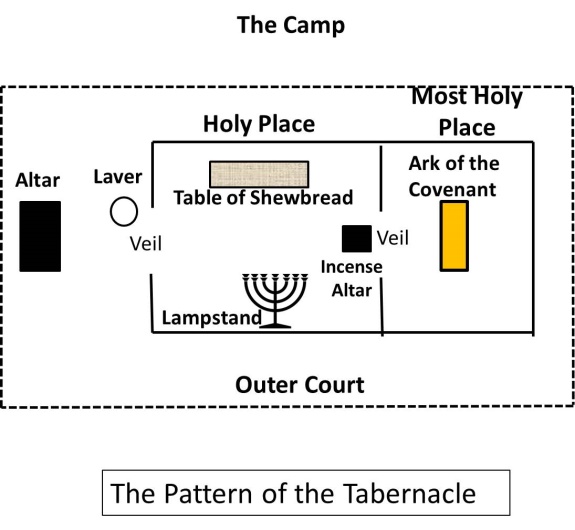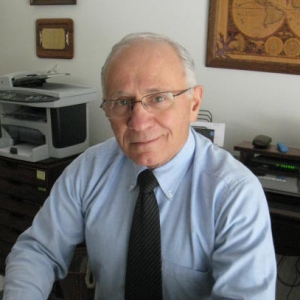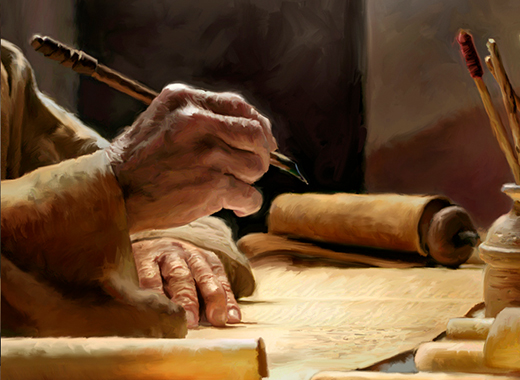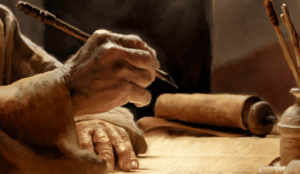”Therefore, brethren, since we have confidence to enter the holy place by the blood of Jesus, by a new and living way which He inaugurated for us through the veil, that is, His flesh, and since we have a great priest over the house of God, let us draw near…” Heb. 10:19-22
The thoughts conveyed by this verse of scripture are too lofty for the natural mind. It is as Jesus told Nicodemus that unless he was born again (Of His Spirit) that he could not even see, less enter into, the Kingdom of God—the Kingdom of God not being some touchable realm or some mystical dimension, but an inward awakening to a relationship with God in Christ Jesus. The things of the Spirit are incomprehensible to the natural mind that wants only to consider things in the natural: crosses, pictures, icons, altars, of sacrifices, fonts for washing, rituals and ceremonies. Many will have difficulty understanding the spiritual nature of Christ and of the Kingdom of God; they seem only to be able to dwell upon the historical Christ, the earthly One, He that was shrouded in the flesh (body) of Jesus, who walked this earth, taught, set an example, and died upon the cross on their behalf. Fixed also upon the past work of the crucifixion, and a future hope of heaven, they never can entertain the present and future reality of the eternal nature of the cross. Let us explore this further.
The Veil of the Body of Christ
Being hewn from a tree, the cross upon which Jesus was crucified was most real, and tangible. It served God’s purpose for His crucifixion in the flesh. At that time, the body of His flesh was a veil to Jesus’ deity, for what one could not see through this veil of His flesh was His eternal nature. “For in Him all the fullness of Deity dwells in bodily form.” Col. 2.9 He is the Christ, the Son of the Living God. He always was and always will be eternally divine—from everlasting to everlasting. The eye of man could not see this nor could his hand touch it nor could it be realized through any of his physical senses or reasoning powers. Christ’s true nature was hidden beneath the veil, of His flesh. Do you see this? Recalling a few stanzas from an old carol, Hark the Herald Angles Sing:
Veiled in flesh, the Godhead see;
Hail, th’incarnate Deity:
Pleased, as man, with men to dwell,
Jesus, our Emmanuel!
Isaiah the prophet wrote of Him, “He has no stately form or majesty that we should look upon Him, nor appearance that we should be attracted to Him.” Is. 53.2 The flesh of Christ was but a veil concealing His glorious incarnate Deity. It is so important that we understand that the crucifixion, His blood shed and His body torn on the cross, unveiled the resurrected Christ in fullness of His glory, a mystery of God now revealed. Christ now has a resurrected body befitting deity status. All the mysteries of God, such as this, are not to remain secrets, but are to be unveiled to the believer.
The Veil of the Cross
There is too an eternal nature veiled in the cross of Christ itself. This rustic “old wooden cross” existed at a point in time for a purpose. Yet, veiled within that cross, is a mystery waiting to be revealed. For those who have an ear to hear, let them hear. There is an eternal nature to the cross that transcends time and space and matter. This cross existed unseen at creation in the mind of God, hidden in His curse upon Satan, “He shall bruise you on the head, and you shall bruise Him on the heel.” Gn. 3.15. The cross was prefigured in copies and types in various altars erected down through the ages, in the whole of the Old Testament, as well in other religions of the earth. This cross was manifested in physical form one last time on a hill called Golgotha upon which Jesus was crucified. What has been veiled in altars and crosses through the centuries is being unveiled as something eternal, operative today, this hour, and tomorrow, and thereafter.
The scripture, “If we confess our sins, He is faithful and just to forgive us our sins and to cleanse us from all unrighteousness,” 1 Jn. 1.9 speaks of “today.” It is the continuing work of the cross to cleanse, redeem, sanctify and make righteous a people. Many seek for artifacts of the old, the original. “If only I had a splinter of that original cross, how meaningful that would be,” they dream. They may continue speculating, “Maybe it would hold some mystical power.” Of what real value would that splinter be? Someone may pay a large sum of money for it, and it then become lost or stolen the next day. It would have no eternal or spiritual value. Regardless of the emotional or monetary value some might place upon it, it is simply a piece of wood, like a chair Jesus sat upon or perhaps a staff He used for walking.
However, fifty years after the crucifixion, that old wooden cross, now perhaps used for firewood, a piece of furniture, or fence post never to be seen in the context of the cross of Christ again, Paul writes, “I have been crucified with Christ; and it is no longer I who live, but Christ lives in me; and the life which I now live in the flesh I live by faith in the Son of God, who loved me and gave Himself up for me..” Gal. 2.20 O’ do you see the eternal nature of the cross? A half–of-century later the eternal cross is still operative, being visited again and again by Paul and other believers, if by any means there be an unveiling of its divine nature from within, still a place of crucifixion of the flesh and the resurrection of newness of life.
It is finished!
For believers, the Old Testament altars are no more. There is no need for them as the veil that veiled-over the presence and glory of God has been removed: “we have confidence to enter the holy place by the blood of Jesus, by a new and living way which He inaugurated for us through the veil, that is, His flesh.” It is a New Covenant, a new way in Spirit. It is the way of faith, of seeing the invisible nature of the Kingdom, beginning with the resurrected Christ, and now the eternal cross. Relics, artifacts, and images of the past only lock us into the unprofitable realm of religion and the natural, keeping all things within or under the veil, keeping secret the mysteries of God.
There were two veils hung in the tabernacle (see sketch map). The first was between the Outer Court having the altar of burnt offering, and the Holy Place. So it is here, in Outer Court, that we acknowledge the altar as the cross, Christ as the Lamb of God, and we declare Him SAVIOUR. He is our redeemer, our deliverer. “For He rescued us from the domain of darkness, and transferred us to the kingdom of His beloved Son.” Col. 1.13 Now, for those who would believe, this “transferred into the Kingdom” is through the first veil into the Holy Place, the place of Kingdom relationship with God the Father and the Son.

The second veil of the tabernacle hung between the Holy Place and the Most Holy Place, where the presence of God was to dwell above the Ark of the Covenant. Well, types and figures are no more, the Way into the “true” Holiest sanctuary of God has been opened, the veil of His body has been rent, through which we may now draw near to God…in spirit and truth. Our keynote scripture encourages us to enter that place of His abiding presence soberly, reverently, but do draw near with full assurance and most certain confidence. The Father actually seeks such to worship Him.
Symbolism or Spiritual Reality
It is anticipated that by now you have made the clear distinction between symbolism and the spiritual reality of a veil. A cross may be displayed or even worn to represent the cross upon which Jesus was crucified. As such, it is an icon, an image, a mere model of reality. However, one could never display the eternal cross veiled by the Golgotha cross, for this cross is spiritual and therefore invisible, penetrating, powerful and able to forever alter one’s life. Compare, for example, the following two scriptures: ”They took Jesus, therefore, and He went out, bearing His own cross, to the place called the Place of a Skull, which is called in Hebrew, Golgotha,” Jn. 19.17, and “But may it never be that I would boast, except in the cross of our Lord Jesus Christ, through which the world has been crucified to me, and I to the world.” Gal 6.14 The first cross is historical, tangible, and temporary. The latter cross is spiritual, invisible, and eternal.
The first Golgotha cross is but a veil, an outward image for the latter, the eternal spiritual cross that works in the believer that transcends time and space. One and only One could bear the Golgotha cross. But the “I” in the second verse of Gal.6.14 was voiced by the apostle Paul in about 50AD and has been declared by believers down through the ages of time… even unto this moment where you and I may declare in equal faith boast in this eternal cross of Christ, “through which the world has been crucified to me, and I to the world.”
There are two more ready applications of this mystery of the veil, that of baptism and of the Lord’s Supper (Communion.) These are two great rites of the Church, which may be practiced symbolically and ritually or experienced in eternal spiritual reality.
The Veil of Baptism
“Go therefore and make disciples of all the nations, baptizing them in the name of the Father and the Son and the Holy Spirit, Mt. 28.19 When applied symbolically and ritualistically this water baptism has divided churches and split denominations based upon methods used and prayers pronounced. It has been used as a rite of passage into church membership and the official title of “Christian.” It is religiously and symbolically Christian. The Corinthian church was divided pompously over who baptized them, whether Paul, Apollos, or Cephas (Peter). All of this is without spiritual merit. Paul rebuked this church for being without wisdom, as infants, and carnal in nature. However baptism may have been applied in the past, and under whatever circumstances viewed today, this Christian rite of baptism is but a veil for a far deeper and eternal work of God in the lives of believers.
Shrouded in formulas and rituals; in ponds and fonts; by anointing, sprinkling, and submergence; with scriptures read, confessions made, and prayers voiced; baptism has a far greater spiritual meaning. May its mystery be unveiled. It is of the spirit, intangible, yet again penetrating to the heart and powerful for the altering of one’s soul. Let us read the unveiled mystery of baptism:
“How shall we who died to sin still live in it? Or do you not know that all of us who have been baptized into Christ Jesus have been baptized into His death? Therefore we have been buried with Him through baptism into death, so that as Christ was raised from the dead through the glory of the Father, so we too might walk in newness of life. For if we have become united with Him in the likeness of His death, certainly we shall also be in the likeness of His resurrection, knowing this, that our old self was crucified with Him, in order that our body of sin might be done away with, so that we would no longer be slaves to sin; for he who has died is freed from sin.” Rm. 6.2-6
True baptism comes down to more a measure of faith in this spiritual component than all the acts and traditions performed. The waters of baptism are but a spiritual grave in which an old nature, having died (at the cross of Christ), is laid to rest. Up from the watery grave one arises into newness of life. Old things are reckoned gone, behold all things have become new. “Therefore if anyone is in Christ, he is a new creature; the old things passed away; behold, new things have come.” 2 Cor. 5.17 It is as crossing over a threshold leaving one room behind and entering another altogether different chamber. This is stepping into the Kingdom of God.
The Veil of the Lord’s Supper
“For I received from the Lord that which I also delivered to you, that the Lord Jesus in the night in which He was betrayed took bread; and when He had given thanks, He broke it and said, “This is My body, which is for you; do this in remembrance of Me.” In the same way He took the cup also after supper, saying, “This cup is the new covenant in My blood; do this, as often as you drink it, in remembrance of Me.” For as often as you eat this bread and drink the cup, you proclaim the Lord’s death until He comes.” 1 Cor. 11.23-26
Please understand that the communion elements of bread and wine are but a veil. As the thick veil of the tabernacle hung over the Most Holy Place hiding the glorious mystery of the sanctuary of God from anything of the natural, so too the communion elements hang over the mystery of the body and blood of Christ—waiting to be lifted by faith. The elements are not holy in themselves, even as the old wooden cross was not holy in itself, but is a veil, a standard, for something far more glorious. I am saddened and dismayed at the symbolism and ritualism and false notions surrounding the practice of the Lord’s Supper among the churches and believers today. Catholics believe that the communion elements actually become (transfiguration) the body and blood of Christ; that the elements become sacred and must be handled in a special way only by the priests. While other protestant groups believe that the supper, and the bread and wine are merely symbolic, and are to be eaten reverently in remembrance. All of this is just a religious pretense and, aside from temporarily pacifying one’s own conscience, is without merit.
To entertain the eternal nature of things, we must first remove this religious shroud of the Lord’s Supper and allow truth to be revealed. “Jesus said to them, ‘I am the bread of life.’” Jn. 6.35 He went on to say, “I am the living bread that came down out of heaven; if anyone eats of this bread, he will live forever; and the bread also which I will give for the life of the world is My flesh.”Jn. 6.51 These words are irrational and illogical to the natural or carnal mind. The words are an allegory of a mystery to be revealed. Without faith, which transcends time, space, and matter, they are merely lofty words. But to the believer these words are life itself. Jesus continued on pressing the point until those without an ounce of faith, faith not the size of a mustard seed, departed from Him,
“So Jesus said to them, ‘Truly, truly, I say to you, unless you eat the flesh of the Son of Man and drink His blood, you have no life in yourselves. He who eats My flesh and drinks My blood has eternal life, and I will raise him up on the last day. For My flesh is true food, and My blood is true drink. He who eats My flesh and drinks My blood abides in Me, and I in him. As the living Father sent Me, and I live because of the Father, so he who eats Me, he also will live because of Me. This is the bread which came down out of heaven; not as the fathers ate and died; he who eats this bread will live forever.” Jn. 6.53-58
Many of the disciples bulked at these words saying, “This is a difficult statement; who can listen to it?” Jn. 6.60 As a result, it is written that “many of His disciples withdrew and were not walking with Him anymore.” Jn. 6.66 But to the handful of disciples remaining, having a glimmer of faith in the unseen, stood with Simon Peter who said, “Lord, to whom shall we go? You have words of eternal life.” Jn. 6.69
An allegory is a story within a story. It has a “surface story” and another story hidden underneath. Only a veil separates the two. In the case of the Lord’s Supper, the words of Christ here in John 6 are not figurative, nor are they merely to teach some moral lesson. They are intended to unveil life, experiential spiritual life, tapped into only by faith—in the unseen and intangible reality of the Lord’s Supper.
Jesus was saying that the Lord’s Supper was to be personal, a time of communion between Himself and the believer—Spirit to spirit. This word communion (Gk. koinónia) means to participate in, share in, have fellowship in One and another’s life in the spirit. If I meet with another about business, then the focus is about such business dealings. If I meet with another about fishing, the focus is about catching fish. If however, I meet with another over a meal, the focus is not about food and drink, but about fellowship, touching one and another’s life.
Pardon the regression here, but I would like to relate a physical law. Heat energy can only be passed from something hotter into something colder, i.e., from the greater to the lesser. A warm object can never become warmer by taking some heat from a colder object. So, the hotter the first body, the more heat energy may be transferred into a second, colder body, and, that second body is no longer as cold for it has gained a measure of heat. When in intimate fellowship with another, the “greater” will always impart a measure of his greater qualities into the “lesser.” Think for a moment of “greater” qualities in an individual. In the natural we may consider such things as zeal for a cause, cunningness in decision making, valor or courage under fire, compassion or empathy for others, salesmanship, and leadership qualities.
But now think for a moment of “greater” spiritual qualities, such as what is possessed by Christ:
“Come to Me, all you who are weary and burdened, and I will give you rest.Take My yoke upon you and learn from Me; for I am gentle and humble in heart, and you will find rest for your souls. For My yoke is easy and My burden is light.” Mt. 11.28-30
“Grace and peace be multiplied to you in the knowledge of God and of Jesus our Lord; seeing that His divine power has granted to us everything pertaining to life and godliness, through the true knowledge of Him who called us by His own glory and excellence. For by these He has granted to us His precious and magnificent promises, so that by them you may become partakers of the divine nature, having escaped the corruption that is in the world by lust.” 2 Pet. 1.2-4
“Peace I leave with you; My peace I give to you; not as the world gives do I give to you. Do not let your heart be troubled, nor let it be fearful.” Jn. 14.27
“A new commandment I give to you, that you love one another, even as I have loved you, that you also love one another.” Jn. 13.34
I will stop here with these few examples of His greatness of qualities. Jesus Christ bears these qualities in absolute proportions. These cannot be emulated as religion would attempt to do, but only be transmitted as life in the intimacy of communion with Christ. So, in the intimacy of the Lord’s Suppers, Christ still beckons…
“Behold, I stand at the door and knock. If anyone hears My voice and opens the door, I will come in and dine with him, and he with Me.” Rev. 3.20
Though religion would tend to lock tight and hold dear these veils, and define its very existence by these veils, Jesus promised, “ I came that they may have life, and have it abundantly.” Jn. 10.10



